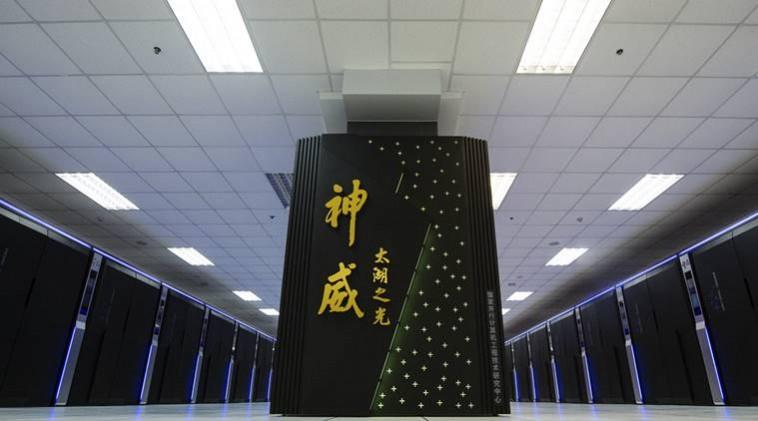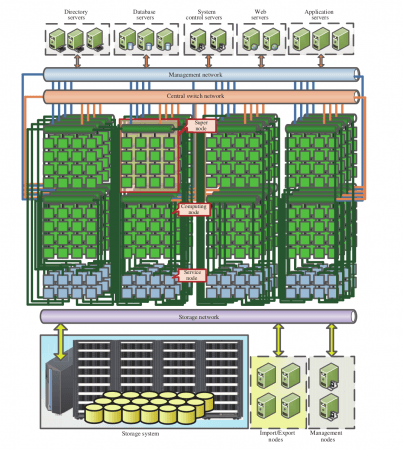
Two Chinese supercomputers, Sunway TaihuLight and Tianhe-2, continue to be the world's fastest number-crunchers while their American counterpart Titan slipped to the fourth place, according to the latest edition of the T0P500 list of supercomputers released on Monday.
The T0P500 list, released twice annually, described the Sunway TaihuLight as "far and away the most powerful number-cruncher on the planet." The supercomputer, which is built entirely using home-grown processors, managed to perform 93 petaflops. A petaflops is a unit of computing speed equal to thousand trillion floating point operations per second.
The Sunway TaihuLight, which maintained its lead since June 2016, was developed by China's National Research Center of Parallel Computer Engineering & Technology (NRCPC). The machine is currently installed at the National Supercomputing Center in Wuxi.
Tianhe-2, which occupied the number two position with 33.9 petaflops, was the number one system on the TOP500 list for three consecutive years, until the Sunway TaihuLight dethroned it in June last year.
Developed by China's National University of Defense Technology (NUDT), the Tianhe-2 is currently deployed at the National Supercomputer Center in Guangzho. The system is based on Intel chips, something the US government had stopped the company from selling to four Chinese supercomputing institutions since 2015.

"China is simultaneously developing hardware and software technologies of supercomputers," Haohuan Fu, deputy director of the National Supercomputing Center, told Xinhua. "It is expected that rapid development in home-grown hardware technologies, supported by home-grown software, will lead to a stronger research and engineering test capacity in many fields, thus promoting an industrial upgrading and, eventually, a sustainable development of China's home-grown supercomputing industry."
According earlier reports, China plans to build a prototype exascale computer by the end of 2017, which can do billion, billion calculations per second. If true, this would undoubtedly cement its position as a world leader in supercomputer.
Meanwhile, the upgraded Piz Daint, a system installed at the Swiss National Supercomputing Center, stood at the number three position with a performance of 19.6 petaflops.
The Swiss machine pushed Titan, a machine installed at the US Oak Ridge National Laboratory, to the fourth spot. Titan's score of 17.6 petaflops has remained constant since it was installed in 2012, according to the TOP500 listing.
"With the two Chinese supercomputers and one Swiss system occupying the top of the rankings, this is the second time in the 24-year history of the TOP500 list that the United States has failed to secure any of the top three positions. The only other time this occurred was in November 1996, when three Japanese systems captured the top three spots," the listing said.
Here're the remaining supercomputers, rounding out the top 10 positions:
- Sequoia (17.2 petaflops), an IBM BlueGene/Q system installed at the DOE's Lawrence Livermore National Laboratory
- Cori (14.0 petaflops), a Cray XC40 system housed at the National Energy Research Scientific Computing Center (NERSC)
- Oakforest-PACS (13.6 petaflops), a Fujitsu PRIMERGY system running at Japan's Joint Center for Advanced High Performance Computing
- Fujitsu's K computer (10.5 petaflops), installed at the RIKEN Advanced Institute for Computational Science (AICS)
- Mira (8.6 petaflops), an IBM BlueGene/Q system installed at DOE's Argonne National Laboratory
- Trinity (8.1 petaflops), a Cray XC40 system running at Los Alamos National Laboratory
Although none of the US machines featured in top three, they claimed five of the top 10 supercomputers, which is more than any other nation. Out of the total of 500 systems, the US claimed 169, which is also the highest by any nation, followed by China with 160 systems.

















